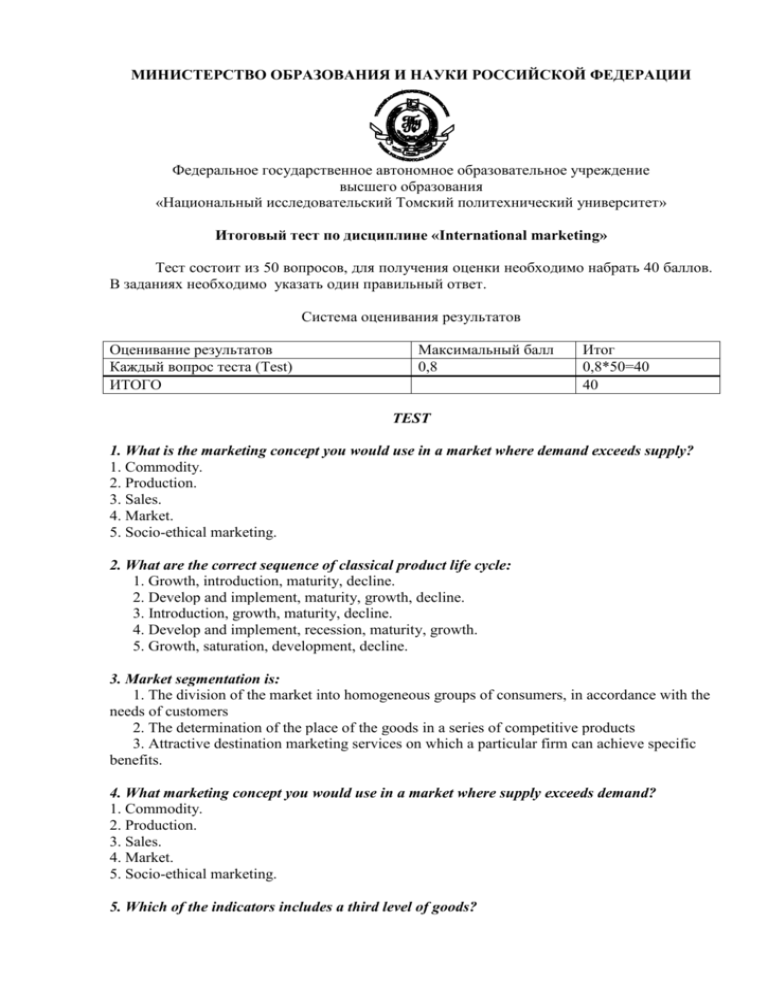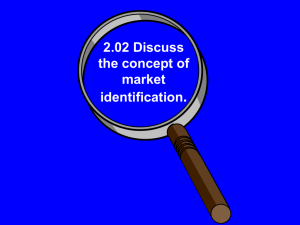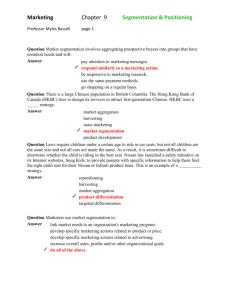МИНИСТЕРСТВО ОБРАЗОВАНИЯ И НАУКИ РОССИЙСКОЙ
advertisement

МИНИСТЕРСТВО ОБРАЗОВАНИЯ И НАУКИ РОССИЙСКОЙ ФЕДЕРАЦИИ Федеральное государственное автономное образовательное учреждение высшего образования «Национальный исследовательский Томский политехнический университет» Итоговый тест по дисциплине «International marketing» Тест состоит из 50 вопросов, для получения оценки необходимо набрать 40 баллов. В заданиях необходимо указать один правильный ответ. Система оценивания результатов Оценивание результатов Каждый вопрос теста (Test) ИТОГО Максимальный балл 0,8 Итог 0,8*50=40 40 TEST 1. What is the marketing concept you would use in a market where demand exceeds supply? 1. Commodity. 2. Production. 3. Sales. 4. Market. 5. Socio-ethical marketing. 2. What are the correct sequence of classical product life cycle: 1. Growth, introduction, maturity, decline. 2. Develop and implement, maturity, growth, decline. 3. Introduction, growth, maturity, decline. 4. Develop and implement, recession, maturity, growth. 5. Growth, saturation, development, decline. 3. Market segmentation is: 1. The division of the market into homogeneous groups of consumers, in accordance with the needs of customers 2. The determination of the place of the goods in a series of competitive products 3. Attractive destination marketing services on which a particular firm can achieve specific benefits. 4. What marketing concept you would use in a market where supply exceeds demand? 1. Commodity. 2. Production. 3. Sales. 4. Market. 5. Socio-ethical marketing. 5. Which of the indicators includes a third level of goods? 1. Mark. 2. External design. 3. Guarantee. 4. Quality. 5. Weight. 6. Which of the indicators includes a second level item? 1. Advertising. 2. Discounts. 3. Terms of delivery. 4. Consumer properties. 5. Service. 7. Which of the indicators includes a first level item? 1. The main benefits and values. 2. Properties. 3. Credit. 4. Advertising. 5. Image. 8. Association of potential customers into groups that have similar needs and react similarly to specific marketing efforts of the company, called: 1. Cross tabulation. 2. Differentiation of a product. 3. Segmentation of the market. 4. Positioning of a product. 9. Marketing - is: 1. Orientatsiya production and marketing to meet the identified customers 2. The organization of marketing activity of the enterprise 3. Organization of production of the company 4. The organization of promotional activities needs of target 10. Positioning - is: 1. The definition of a place for their goods in the market and in the minds of buyers. 2. The desk research market. 3. The division of the market for consumer tastes. 4. Splitting into groups of consumers, equally responsive to one and the same set of marketing stimuli. 11. For the segmentation of the market of consumer goods are not essential, the following criteria: 1 The physiological. 2. The behavioral. 3. The demographic. 4. The psychological. 12. The company has decided to move from demographic segmentation to the psychological. In this case it should use the indications: 1. Personal characteristics, motives, lifestyle. 2. Climatic and territorial. 3. The age and gender and economic. 4. Stadii family life cycle, religious. 13. Segment consists of: 1. Of consumers, equally responsive to the marketing mix firm. 2. From consumers living in the same city. 3. The employees of the same organization. 4. Sellers of similar goods. 14. The largest increase in sales and profits the firm has at the stage of the life cycle: 1. Growth. 2. Recession. 3. Maturity. 4. Introductions. 15. The complex marketing firm - is: 1. System of marketing information. 2. Marketing intermediaries and competitors. 3. Contact audiences and suppliers. 4. Goods, price, sale and advance. 16. The most advantageous in terms of growth in sales - the stage of the product life cycle: 1. Growth. 2. Recession. 3. Maturity. 4. Introductions. 17. What should be legal registration? 1. The trade mark. 2. Trademark. 3. Name flag. 4. Branded constants. 5. Corporate color. 18. Trading stamp - is: 1. The designation registered in accordance with the established procedure placed on goods. 2. Firm designation, firm color, company name. 3. The company name placed on goods. 4. Name flag. 5. Slogan. 19. Trademark - is: 1. firm designation, firm color, company name. 2. The word, letter or group of words, letters. which can be uttered. 3. Personified trade mark. 4. Name flag. 5. Slogan. 20. What is important in determining the marketing? 1. The sale of goods. 2. Reduction of production costs. 3. Meet the needs of the consumer. 4. Improve the quality of life. 5. The establishment of the price of the goods. 21. Give the definition of the main principles of marketing: 1. Most importantly - is to make production and marketing of it will find. 2. The main thing - it does not sell what is already made, and to produce something that will be sold. 3. The search for new customers is the main method of competition. 22. For what kind of market segmentation is characterized by the separation of customers, depending on their level of knowledge, the nature of use of the product and the reaction to this article? 1. For segmentation by demographic characteristics. 2. For the segmentation on the production lines. 3. For segmentation behavioral traits. 4. To segment on psychological grounds. 23. What are the factors of market segmentation are a group of behavioral? 1. The desired benefits, the intensity of the consumer, the degree of brand loyalty, the relation to the product. 2. The desired benefits, the intensity of the consumer, the degree of brand loyalty, attitude towards product 3. Population density, lifestyle, personality type. 4. Age, gender, population density, the size of the family. 24. What is the concept of "market segment"? 1. The set of consumers, equally responsive to the same set of incentives marketing. 2. Product differentiation of the market for the main groups of goods and brands. 3. The system of organizing product distribution of consumer goods. 4. Feature set of different groups of producers in a specific regional market. 25. To what stage of product life cycle is characterized by an extremely slow growth of sales of goods? 1. For the growth stage. 2. For the stage of decline. 3. For stages of maturity. 4. For the phase-to-market. 26. At what stage of the product life cycle company gets the maximum profit: 1. The implementation phase. 2. Recession. 3. Maturity. 4. Growth. 27. Marketing - is: 1. To produce what the customer needs and being sold on the market. 2. Sell something that has already been applied without regard to consumer preferences. 28. The company sells one type of ballpoint pen at the same price. In its activities, the company focuses on the entire market. What is the concept of coverage of the target market, it should be used: 1. The concept of differentiation. 2. The concept of mass coverage. 3. The concept of concentrated coverage. 4. The concept of focus. 29. If the market is deficient, and buyers prefer to have products available and cheap, what is reasonable to use the concept of marketing firm: 1. The concept of industrial marketing. 2. The concept of supply marketing. 3. The concept of commodity. 4. The concept of consumer marketing. 30. If the market is saturated and heterogeneous on the desired benefits and tastes, and the buyer prefers to product quality and variety of the range, then the company should be used following the marketing concept: 1. The concept of industrial marketing. 2. The concept of supply marketing. 3. The concept of commodity. 4. The concept of consumer marketing. 31. If the priority is to protect the consumer society, the development needs of healthy and environmentally friendly technologies, what the marketing concept is advisable to use the company: 1. The concept of industrial marketing. 2. The concept of supply marketing. 3. The concept of commodity. 4. The concept of consumer marketing. 5. The concept of social marketing. 32. What is the concept of marketing has historically been the first 1. The concept of industrial marketing. 2. The concept of supply marketing. 3. The concept of product marketing. 4. The concept of consumer marketing. 5. The concept of social marketing. 33. If the company produces and sells products at prices diverse, quality, range, demographic characteristics, the company is advisable to use the following strategies to reach the target market: 1. The mass coverage strategy. 2. The strategy of differentiated coverage. 3. Concentrated strategy. 34. If the company offers the market a unique product, what strategies to reach the target market should be used: 1. The mass coverage strategy. 2. The strategy of differentiated coverage. 3. Concentrated strategy. 35. How many approaches to understanding the essence of marketing exists in theory and in practice: 1. One. 2. Three. 3. Two. 4. Four. 36. Which of the definitions of marketing is the right one: 1. Marketing - promotional activities of the company to promote their products. 2. Marketing - is any market activities of the company. 3. Marketing - is the organization and management of all activities of the company to of goods and services that have value for customers. 4. Marketing - marketing activity of the company. provision 37. What criteria of market segmentation is used in marketing: 1. Three. 2. Four. 3. Five. 4. Two. 38. When segmenting the market into homogeneous groups of consumers purchasing behavior uses the following criteria segmentation: 1. Psychological. 2. The socio-economic. 3. Demographic. 4. Behavioral. 39. Market segmentation by gender and age criterion is used: 1. The socio-economic. 2. Territorial. 3. Behavioral. 4. Demographic. 5. Psychological. 40. Market segmentation based on consumption. Style and way of life criterion is used: 1. Demographic 2. The socio-economic 3. Psychological 4. Behavioral 41. In the consumer market segmentation by level of education and professions criterion is used: 1. Psychological. 2. The socio-economic. 3. Behavioral. 4. Territorial. 42. Taking into account the size and density of the population in the target market criterion is used: 1. The socio-economic. 2. Demographic. 3. Territorial and geographical. 4. Behavioral. 43. How many levels have the goods in marketing: 1. One. 2. Three. 3. Two. 4. Four. 44. The essence of the product revealed: 1. The second level. 2. In the first level. 3. The third level. 45. The main benefits and values that carries goods to consumers, expressed: 1. The subject goods in the form of specific performance. 2. The nature of the goods. 3. Competitive environment and strengthening commodity. 46. The principle of marketing is: 1. Focus on cost reduction. 2. Orientation to the market and consumers. 3. Focus on competitors. 47. Which of the following functions is a function of marketing: 1. Motivation. 2. The regulatory function of internal business processes. 3. Analytic function. 4. The function of coordination with suppliers. 48. In the marketing mix includes the following tools market development: 1. The analysis of competitors, suppliers and customers. 2. The analysis of the product and consumers. 3. The analysis of the market, product, price and promotion. 4. The analysis of the market, product, price, promotion and consumer. 49. In some of the concepts the company is committed to continuous improvement in the quality and range of products: 1. Production concept. 2. The marketing concept. 3. The concept of commodity. 4. The concept of consumer marketing. 50. What is the most important factor in deciding the concept of social marketing: 1. The buyer need. 2. Interests of the company. 3. Social interests. 4. Interests technological progress.







